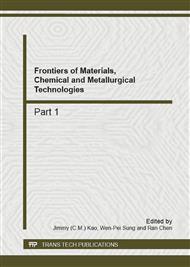[1]
X.H. An, Q.Y. Lin, S.D. Wu, Z.F. Zhang, R.B. Figueiredo, N. Gaoc and T.G. Langdon, The influence of stacking fault energy on the mechanical properties of nanostructured Cu and Cu–Al alloys processed by high-pressure torsion , Scripta Mater.64 (2011) 954-957.
DOI: 10.1016/j.scriptamat.2011.01.041
Google Scholar
[2]
C. X. Huang, G. Yang, C. Wang, Z. F. Zhang, S. D. Wu, Mechanical behaviors of ultrafine-grained 301 austenitic stainless steel produced by equal-channel angular pressing, Metall. Mater. Trans.42 (2010) 2061-2071.
DOI: 10.1007/s11661-010-0575-x
Google Scholar
[3]
N. Kamikawa, X X Huang, N Tsuji, N Hansen, Strengthening mechanisms in nanostructured high-purity aluminum deformed to high strain and annealed, Acta Mater. 57(2009), 4198-4208.
DOI: 10.1016/j.actamat.2009.05.017
Google Scholar
[4]
H. Miura , T. Sakai, S. Maruoka, J. J. Jonas, Production of recrystallized nano-grains in a fine-grained Cu–Zn alloy, Philos. Mag. Lett.90(2010)93-101.
DOI: 10.1080/09500830903459648
Google Scholar
[5]
H.P. Klug, L. Alexander, X-ray Diffraction Procedures for Polycrystalline and Amorphous Materials, 2nd ed. Wiley, New York, 1974, p.661.
Google Scholar
[6]
T. Venugopal, K. Prasad Rao, B.S. Murty, Mechanical and electrical properties of Cu−Ta nanocomposites prepared by high-energy ball milling, Acta Mater. 55(2007) 4439−4445.
DOI: 10.1016/j.actamat.2007.04.025
Google Scholar
[7]
R.E. Smallman, K.H. Westmacott , Stacking faults in face-centred cubic metals and alloys [J],Philos. Mag. 2 (1957) 669−683.
DOI: 10.1080/14786435708242709
Google Scholar
[8]
G.K. Williamson, R.E. Smallman, Dislocation densities in some annealed and cold-worked metals from measurements on the X-ray DEBYE-SCHERRER spectrum. Philos. Mag. 1 (1956) 34−36.
DOI: 10.1080/14786435608238074
Google Scholar
[9]
Y.H. Zhao, Y.T. Zhu, X.Z. Liao, Z. Horita, Langdon TG. Tailoring stacking fault energy for high ductility and high strength in ultrafine grained Cu and its alloy,Appl. Phys. Lett. 89(2006)121906.
DOI: 10.1063/1.2356310
Google Scholar
[10]
Y. H. Zhao, Z. Horita, Langdon TG, Y.T. Zhu. Evolution of defect structures during cold rolling of ultrafine-grained Cu and Cu–Zn alloys influence of stacking fault energy. Mater Sci Eng .A 474(2008)342−347.
DOI: 10.1016/j.msea.2007.06.014
Google Scholar
[11]
C.N.J. Wagner. Stacking faults by low-temperature cold work in copper and alpha brass. Acta Metall .5(1957)427–34.
DOI: 10.1016/0001-6160(57)90060-3
Google Scholar
[12]
X. Huang, N .Hansen, N. Tsuji, Hardening by annealing and softening by deformation in nanostructured metals, SCI. 312 (2006) 249-251.
DOI: 10.1126/science.1124268
Google Scholar
[13]
X .X .Huang, Tailoring dislocation structures and mechanical properties of nanostructured metals produced by plastic deformation, Scripta Mater. 60 (2009) 1078-1082.
DOI: 10.1016/j.scriptamat.2009.02.018
Google Scholar


